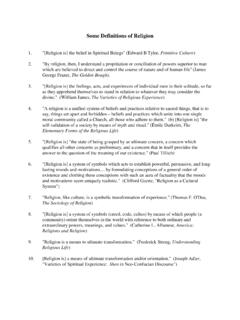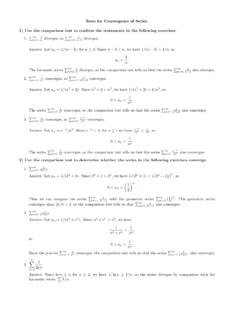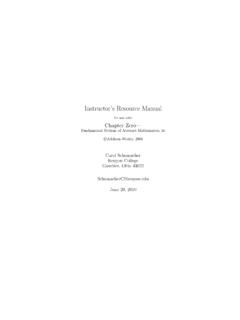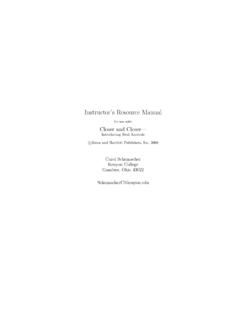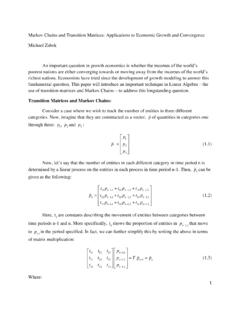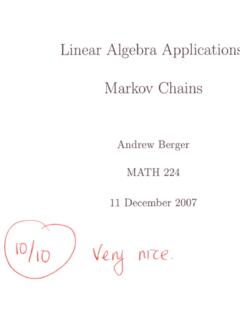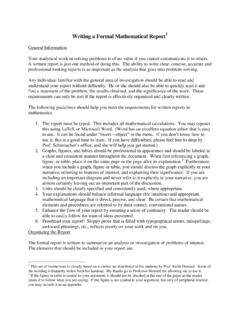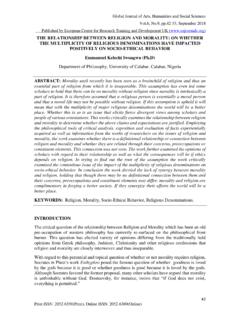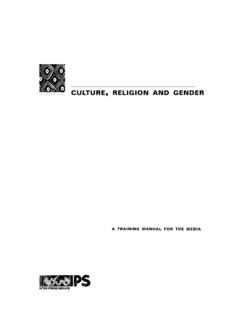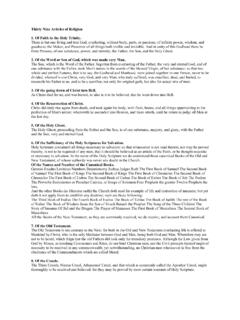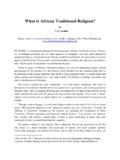Transcription of Confucianism in China Today - Kenyon College
1 Confucianism in China TodayPearson Living Religions ForumNew YorkApril 14, 2011 Joseph A. AdlerKenyon CollegeConfucianism, Confucius, and his missionMy topic is Confucianism in China Today . But I believe that itis always helpful, and perhaps necessary, to understand the present inthe context of the past. And since most people have only a cursoryknowledge of Confucianism , I will begin with a survey of thedevelopment of the tradition. Confucianism is a religious and philosophical tradition datingback 2500 years in China , which later spread throughout East the man we know as Confucius said he was not a creatorbut rather a transmitter of older values and traditions, it is fair toconsider him the founder. His actual name was Kong Qiu, and hewas generally known as Master Kong (Kongzi). A more honorificvariant of that name, Kong Fuzi, was Latinized by 17th-century Jesuitmissionaries as Confucius. Master Kong was born in 551 BCE in easternChina, during the period known as the Eastern Zhoudynasty.
2 The Zhou political structure had beendisintegrating for over 200 years during his lifetime,and Confucius' mission was to restore social andpolitical harmony by reviving the moral character of theruling class and the literate elite. The three majorvirtues he felt were the basis of morality werehumanity/humaneness (ren), ritual propriety (li), andfilial respect (xiao). Humanity/humaneness, he said,was the essential goodness and love for others thatConfucius (Kongzi), 551-479 BCE)2distinguishes us from other animal species. As his later follower, Mencius, put it, "To be human is tobe humane." Ritual propriety (li) is the necessary outward expression in behavior of that humanity,and must be consistent with culturally specific norms. Filial respect (xiao), or respect for elders, is anaturally-occuring virtue that is the building block of the other virtues. In later centuries filial respectwould become by far the best-known Confucian virtue, with both good and bad results.
3 Confucius' followers were known as ru or "scholars,"because they came to be the experts in the rituals and arts thoughtto be necessary for good governance and a cultured life. There wasnever until modern times a Chinese equivalent for the term" Confucianism ;" the tradition was called the "teaching of the ru"(rujiao) or the learning of the ru (ruxue). After Confucius' death,three or four generations of his followers compiled his oralteachings into a book called the Lunyu, or Analects of Confucius. Confucius and disciplesOpening page of the Lunyu , or Analects of Confucius(with interlinear commentary)3 MenciusThe second great sage in this tradition after Confucius was Mencius another Latinized name, for Master Meng (Mengzi) who lived in the 4thcentury BCE. He made explicit certain ideas that were only implicit in theteachings of Confucius. The most important of these was the claim that humannature is inherently good ; goodness is a natural human instinct, as natural asour four limbs and our desires for food and sex.
4 And this natural, moralinclination is given to us by Heaven (actually Confucius had also explicitlysaid that our "virtue" was given by Heaven). "Heaven" (tian) in Confucianthought is a semi-naturalistic, semi-personalistic ultimate reality whose will isfor moral virtue to regulate human life. Mencius was later considered the "orthodox" interpreter ofConfucius, and the teachings of these two sages Today constitute the core of "classical Confucianism ." In the 2nd century BCE, during the Han dynasty, Confucianism was adopted as the officialideology of government analogous to democracy and capitalism in the United States. This proved tohave unfortunate results, both for China and for Confucianism . Since governments have a stronginterest in maintaining social stability, the most socially conservative interpretations of Confucianteachings were encouraged, such as age- and gender-based hierarchy. The resulting "politicizedConfucianism" would be harshly rejected in the 20th century, as we shall see.
5 Confucianism as a religious traditionAt this point it might be useful to raise the question: What is religious about Confucianism ?Isn't it really just a social-political system of ethics? One hears this often, both from scholars and fromothers who have only a passing familiarity with Confucianism . It is a good question, because itcompels us to think more deeply about the nature of religion . The answer depends, of course, on howwe define " religion ." If religion is defined according to the Judeo-Christian model, one might bejustified in saying that Confucianism is not a religion . It is not based on worship of a single, all-powerful creator god; its ideas about life after death are incidental to its central message; and it doesnot have an organized priesthood. But why should our familiar Western religions automatically be used as the standard for whatany real religion must be? There have been many attempts to define religion in more culturally-Mencius (Mengzi), 4th c.
6 BCE4neutral ways. My view is that we need not settle on a single definition, because religion is a multi-dimensional set of phenomena that can be viewed from a variety of perspectives; different definitionsmight shed light on different aspects of this set of phenomena. For example, Frederick Streng hasproposed that religion is "a means to ultimate transformation." This implies (a) that the humancondition is viewed as in some way flawed, and therefore in need of transformation; (b) that there is agoal of that transformation that depends on the nature of the inherent flaw; and (c) that there is ameans of attaining that goal. The definition also implies that this process of transformation beconsidered in some sense "ultimate." Confucianism clearly fits this definition. The problem with the human condition is that we arenot aware of our Heaven-endowed moral potential and/or lack the will to cultivate it. The goal is justthat: to actualize our moral potential, to become fully humane beings, or "sages" (shengren).
7 Themeans of attaining sagehood is "self-cultivation," which requires both self-reflection to distinguishour good inclinations from our bad ones and learning from the moral examples of past sages andteachers. The "ultimacy" factor is seen in the two central elements of Heaven (tian) and the Sage."Heaven," as already mentioned, is the ultimate reality that is the source of moral value and the sourceof the innate goodness of human nature. The Sage is the symbol of the ideal human being who hasfully internalized the will of Heaven. The word shengren or Sage has clear religious overtones. Forexample, it is the Chinese translation of "saint," and the Chinese word for the Bible is sheng jing, orHoly Scriptures. And jing (scriptures), by the way, is also the word used for what is usually called the"Confucian Classics." The same word was used to translate the Sanskrit word sutra after Buddhismentered China from India in the 1st century The Neo-Confucian revivalAfter the fall of the Han dynasty in 220 CE, Confucianism fell into decline.
8 Both Buddhismand Daoism were developing and gaining popularity. (This was the full-fledged Daoist religion ,which began in the 2nd century CE not the "classical" Daoism of the Dao de jing attributed toLaozi.) It was not until the Song dynasty (950-1279) that there was a major revival of , the second great epoch of Confucianism , has also been given a name by Westerners that did not1 See Joseph A. Adler, " Confucianism as a Religious Tradition: Linguistic andMethodological Problems." 5exist in China : "Neo- Confucianism ." This Confucian revival was strongly influenced by Buddhism,and to a lesser extent, Daoism. The most dominant figure of "Neo- Confucianism " was the 12th-centuryscholar Zhu Xi, who synthesized the teachings of his 11th-century forebears intoa coherent system of philosophy and religious practice (focused on "self-cultivation," the process of becoming a Sage), that became the dominantreligio-philosophical worldview of the literate elite until the 20th century.
9 ZhuXi systematized a curriculum of education extending from what we would callelementary school to the level. He also wrote a popular book on "FamilyRituals," which was widely circulated for centuries as the standard for suchrituals as "capping" of young men and "pinning" of young women (both puberty rituals), marriagerituals, treatment of elders, funerals, and ancestor worship. Increasing conservatismAlthough Zhu Xi's system was motivated by his sincere desire to help people achieve orapproach Sagehood, it quickly became co-opted by the state, and therefore politicized. In the early14th century it became the basis of the civil service examination system, which was the mostimportant avenue of social mobility in China . Memorization of Zhu Xi's interpretations of theConfucian tradition therefore became the goal of those hoping to get government jobs, ignoring themoral purpose of the whole system. During the Ming and Qing dynasties, politicized Confucianismwas used to support increasingly conservative agendas, such as absolute obedience of elders and strictsubjugation of women to men.
10 Anti-Confucian movements of the early and mid-20th centuryThis brings us to the 19th and 20th centuries. The last imperial dynasty was the Qing (1644-1911), which was ruled by a non-Chinese ethnic group, the Manchus (who are Today pretty muchblended into the Han Chinese population). At the end of the 18th century the Qing emperor hadrejected a request by King George III of Great Britain (our old friend from colonial days in America)to establish trade relations. Britian needed markets for the products of its new industrial revolution. Itresponded to the Chinese cold shoulder by growing opium in India and selling it illegally in Xi (1130-1200)6 Chiang Kai-shek(1872-1975), leader ofthe Nationalist of Heavenly Peace (Tiananmen)The Opium Wars of the 1840s began a long series of catastrophes for China , including internalrebellions. Meanwhile Japan, which opened its doors to the West after over 200 years of self-imposedisolation, was becoming a modern industrial power, and defeated China in the 1895 Sino-JapaneseWar.
